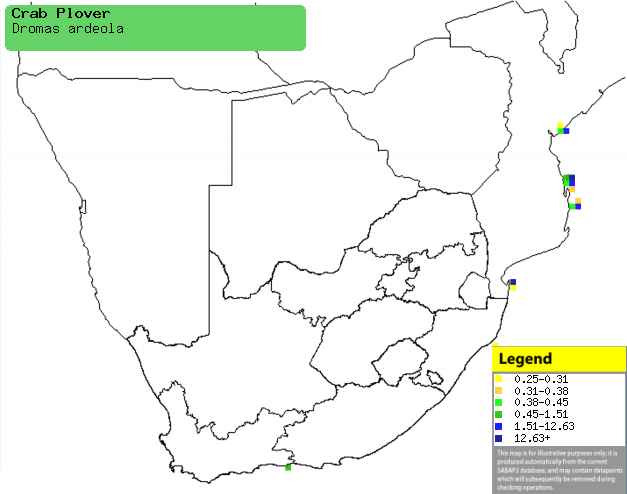|
Dromas ardeola (Crab plover)
Krapvreter [Afrikaans]; Krabplevier [Dutch]; Drome
ardéole [French]; Reiherläufer [German]; Caranguejeiro [Portuguese]
Life
> Eukaryotes >
Opisthokonta
> Metazoa (animals) >
Bilateria >
Deuterostomia > Chordata >
Craniata > Vertebrata (vertebrates) > Gnathostomata (jawed
vertebrates) > Teleostomi (teleost fish) > Osteichthyes (bony fish) > Class:
Sarcopterygii (lobe-finned
fish) > Stegocephalia (terrestrial
vertebrates) > Tetrapoda
(four-legged vertebrates) > Reptiliomorpha > Amniota >
Reptilia (reptiles) >
Romeriida > Diapsida > Archosauromorpha > Archosauria >
Dinosauria
(dinosaurs) > Saurischia > Theropoda (bipedal predatory dinosaurs) >
Coelurosauria > Maniraptora > Aves
(birds) >
Order: Charadriiformes > Family:
Dromadidae
Distribution and habitat
Breeds on coasts and islands of Saudi Arabia, Somalia,
Eritrea, Oman, Abu Dhabi and Iran, heading south in the non-breeding season to
the coast of East Africa and islands of the west Indian Ocean, from
southern Mozambique to the western Bay of Bengal. In southern Africa it is
uncommon and localised, occurring in patches along the coast of Mozambique,
while it is a vagrant to the coast of South Africa. It generally prefers large intertidal flats with firm substratum, while avoiding rocky shores and exposed
sandy beaches.
|
 |
|
Distribution of Crab plover in southern Africa,
based on statistical smoothing of the records from first SA Bird Atlas
Project (©
Animal Demography unit, University of
Cape Town; smoothing by Birgit Erni and Francesca Little). Colours range
from dark blue (most common) through to yellow (least common). |
Movements and migrations
Its movements are not well understood, mainly
because it migrates close to sea level offshore; it is mainly
present in southern Africa in summer, although juveniles often
overwinter.
Food
Not studied in southern Africa, but elsewhere it mainly
eats crabs, doing most of its foraging using the typical technique of plovers,
running, stopping then searching for prey with its head tilted to the side. The following food items have been recorded
in its diet:
- Invertebrates
- crabs
- Marphysa (polychaetes)
- Solen (pencil-bait)
- other bivalves
- shrimps
- Fish
Breeding
Does not breed in southern Africa. It is unique among
shorebirds, breeding colonially in underground burrows, usually situated in an
area with plentiful crabs, suitable substrate for digging and with hardly any
terrestrial predators. Since this type of habitat is quite rare, it is thought
to be the main cause of the Crab plover's rarity. It lays a single egg, which
relative to the body mass of the adult is the largest of any bird.
Threats
Not globally threatened, although its population is small
and concentrated at certain localities and its chicks and eggs are sometimes
collected for food.
References
-
Hockey PAR, Dean WRJ and Ryan PG 2005. Roberts
- Birds of southern Africa, VIIth ed. The Trustees of the John Voelcker
Bird Book Fund, Cape Town.
|
